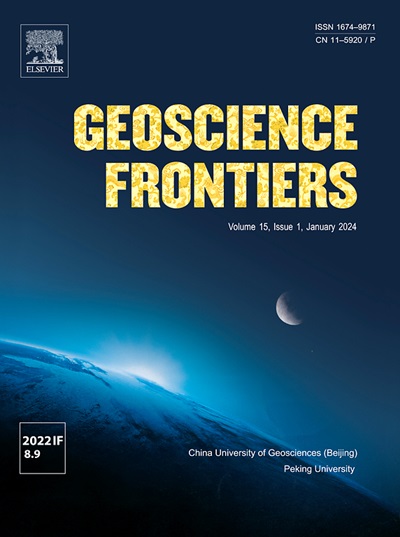基于动态drastic方法的多灾种地下水脆弱性制图
IF 8.9
1区 地球科学
Q1 GEOSCIENCES, MULTIDISCIPLINARY
引用次数: 0
摘要
本文通过整合多灾种地下水指数(MHGI),提出了DRASTIC地下水脆弱性评价框架,以考虑多种人为活动和自然因素对地下水质量和数量的动态影响。将人口增长、农业实践和地下水开采等因素纳入其中,增强了该框架捕捉地下水脆弱性多维时空变化的能力。其他改进包括基于可用观测数据的主题层的精细加权和评级尺度,以及包含分布式补给。我们通过将这一动态的基于drastic方法的框架应用于灌溉印度河流域(南亚主要的地下水依赖农业区)的农业城市地区,展示了它的实际效用。结果表明,2005 - 2020年,54%的研究区成为高易损区。MHGI显示,受人口增长和集约化农业的推动,潜在地下水储存量下降了13%,地下水承压区增加了25%。基于地下水质量和数量维度的地下水脆弱性表明,到2020年,低至极低脆弱性地区下降19%,中等脆弱性地区下降6%。敏感性分析表明,该地区地下水脆弱性受地下水补给(42%)和可再生地下水应力(38%)的影响最大。经现场数据验证,地下水水质脆弱性曲线下面积为0.71,MHGI曲线下面积为0.63。该框架为指导可持续地下水管理、保护环境完整性和人类福祉提供了宝贵的见解。本文章由计算机程序翻译,如有差异,请以英文原文为准。

A dynamic DRASTIC-based approach for multi-hazard groundwater vulnerability mapping
This study advances the DRASTIC groundwater vulnerability assessment framework by integrating a multi-hazard groundwater index (MHGI) to account for the dynamic impacts of diverse anthropogenic activities and natural factors on both groundwater quality and quantity. Incorporating factors such as population growth, agricultural practices, and groundwater extraction enhances the framework’s ability to capture multi-dimensional, spatiotemporal changes in groundwater vulnerability. Additional improvements include refined weighting and rating scales for thematic layers based on available observational data, and the inclusion of distributed recharge. We demonstrate the practical utility of this dynamic DRASTIC-based framework through its application to the agro-urban regions of the Irrigated Indus Basin, a major groundwater-dependent agricultural area in South Asia. Results indicate that between 2005 and 2020, 54% of the study area became highly vulnerable to pollution. The MHGI revealed a 13% decline in potential groundwater storage and a 25% increase in groundwater-stressed zones, driven primarily by population growth and intensive agriculture. Groundwater vulnerability based on both groundwater quality and quantity dimensions showed a 19% decline in areas of low to very low vulnerability and a 6% reduction in medium vulnerability zones by 2020. Sensitivity analyses indicated that groundwater vulnerability in the region is most influenced by groundwater recharge (42%) and renewable groundwater stress (38%). Validation with in-situ data yielded area under the curve values of 0.71 for groundwater quality vulnerability and 0.63 for MHGI. The framework provides valuable insights to guide sustainable groundwater management, safeguarding both environmental integrity and human well-being.
求助全文
通过发布文献求助,成功后即可免费获取论文全文。
去求助
来源期刊

Geoscience frontiers
Earth and Planetary Sciences-General Earth and Planetary Sciences
CiteScore
17.80
自引率
3.40%
发文量
147
审稿时长
35 days
期刊介绍:
Geoscience Frontiers (GSF) is the Journal of China University of Geosciences (Beijing) and Peking University. It publishes peer-reviewed research articles and reviews in interdisciplinary fields of Earth and Planetary Sciences. GSF covers various research areas including petrology and geochemistry, lithospheric architecture and mantle dynamics, global tectonics, economic geology and fuel exploration, geophysics, stratigraphy and paleontology, environmental and engineering geology, astrogeology, and the nexus of resources-energy-emissions-climate under Sustainable Development Goals. The journal aims to bridge innovative, provocative, and challenging concepts and models in these fields, providing insights on correlations and evolution.
 求助内容:
求助内容: 应助结果提醒方式:
应助结果提醒方式:


